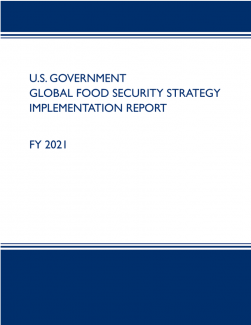As the Global Coordinator for Feed the Future (FTF), the U.S. government’s (USG) global hunger and food security initiative, it is my pleasure to report on the implementation of the U.S. Government’s Global Food Security Strategy (GFSS) for Fiscal Year 2021. This is the fifth annual review of the USG’s commitments, achievements, and lessons learned in reducing global hunger, poverty, and malnutrition.
The past year and a half challenged the world in an unprecedented way. The COVID-19 pandemic swelled the ranks of the poor, pushing 163 million more people into extreme poverty and hunger. In fact, this represents the first global rise in extreme poverty in nearly 30 years. At the same time, the pandemic has exacerbated existing inequalities in food systems, particularly gender inequalities.
In addition to the still-raging COVID-19 pandemic, we are also battling flaring and protracted incidences of conflict, accelerating impacts of climate change, and increasing inequality and gender-based violence. These challenges threaten development progress made over the past decades. But even in the face of these unprecedented issues, I remain hopeful.
The United States has a history of rising to the challenge of food insecurity. In response to the global food crisis of 2007–2008, the USG committed to ending global hunger through the FTF initiative. After the first seven years of FTF, 23.4 million more people lived above the poverty line, 5.2 million more households did not suffer from hunger, and 3.4 million more children lived free of stunting in areas where FTF works. Furthermore, women and women-owned businesses have accessed more than $731 million in financing since 2011 as a direct result of FTF’s global work.
Notably, we are seeing promising signs that some of this progress has continued even in the face of shocks. For instance, recent data indicate that households living in FTF target areas in Malawi and Uganda were more resilient to the economic impacts of COVID-19 than households living outside these areas. Moreover, 2020 monitoring data from across the FTF initiative suggests that most activities were able to continue operations effectively despite the pandemic. I am heartened to see the positive effect that meaningful partnership can have on individuals, families, and their communities. In the years to come, we will continue to face the devastating impacts of the pandemic, entrenched conflict, and climate change. But FTF remains a tested model for building healthy, resilient communities and securing human dignity.
To continue this progress, FTF updated the GFSS through numerous consultations with stakeholders in 2021 and finalized the Strategy in October 2021. The updated GFSS (2022-2026) charts the course to reduce global poverty, hunger, and malnutrition in the face of COVID-19, climate change, and rising inequality and conflict.
In alignment with the Biden-Harris Administration and the March 2021 Interim National Security Strategic Guidance, the new Strategy will:
- Scale up climate adaptation approaches to build resilience, increasing investment in food and water security research and innovation to help communities withstand increasing droughts, irregular rainfall, and diminishing water resources;
- Counter the impact of COVID-19 by strengthening food production and market systems to grow incomes and make a quality diet more affordable for the rural and urban poor;
- Adopt “food systems” approaches across FTF investments, taking into account food’s journey from cultivation to consumption, to increase economic resilience and improve nutrition;
- Integrate conflict sensitivity across FTF programs to anticipate and mitigate food crises caused by increasing conflict; and
- Elevate equity and inclusion throughout FTF programming by collaborating with local partners to create job opportunities for women, young people, and other marginalized groups, and broaden our partner base, diversifying the management of FTF research and programming.
With these priorities, the updated Strategy will continue guiding FTF’s work, charting the next phase of the initiative as we respond to today’s challenges. We look forward to working closely with Congress, partner governments, the private sector, universities, individuals, and other stakeholders to build back better and end global hunger, poverty, and malnutrition.
Sincerely,
Samantha Power
USAID Administrator and Feed the Future Global Coordinator

